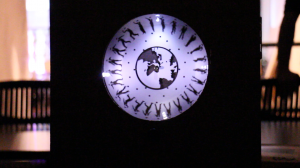Ava I-Wen Huang, Supreet Mahanti
Come closer to find your visual sweet spot.
Description
Moving images that come to life when some sort of movement is sensed. Another way of describing it would be the analog way to visual animation.
Based on the age-old cinematic principle of persistence of vision to create an illusion of movement, this device consists of a circular array of sequential images mounted on a rotational disk. As the viewer steps into range, a series of LEDs light up and start to blink. The intensity of blinking defines the clarity of the images from a blur to a clear animation. This intensity is controlled by the viewers distance from the device: the closer the viewer, the faster the blinking. When the blinking is too fast, the images appear as a blur, when they are too slow i.e., when the viewer is too far, the images lose visibility. This automatically spurs the viewer to find the exact “sweet spot” through a trial and error forwards and backwards motion at which point the animation is revealed at its highest point of clarity.
All this is controlled by a range sensor that senses the distance of a body from in front of the device and adjust the blinking according to a pre-defined range of values, in this case distance mapped to blink speed. Once the viewer is within range and the circular disk lights up to life, she will also notice the playing of music added up to be reminiscent of a form of entertainment of a bygone era.
This device is inspired by the early animation device, the phenakistoscope.
Classes
Introduction to Physical Computing

